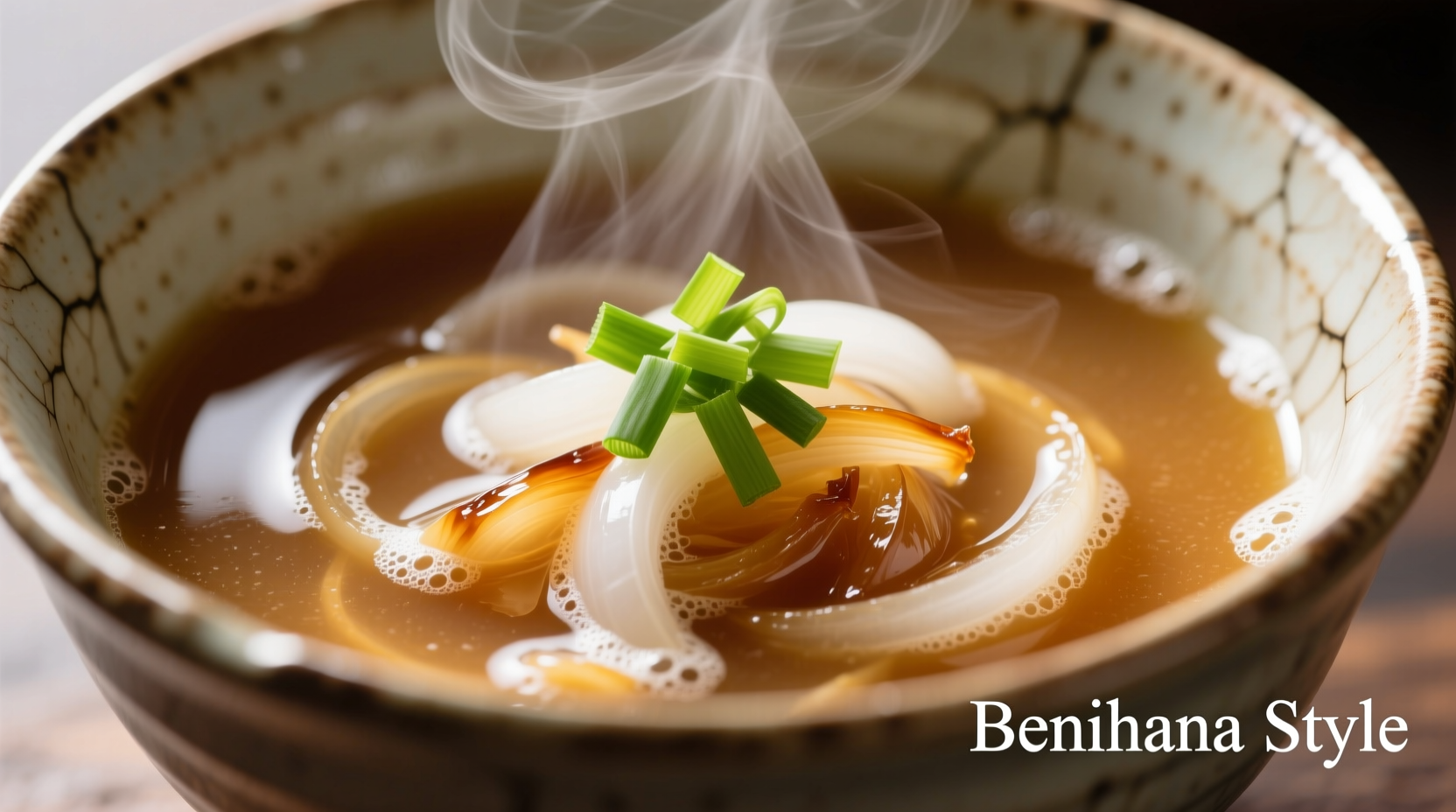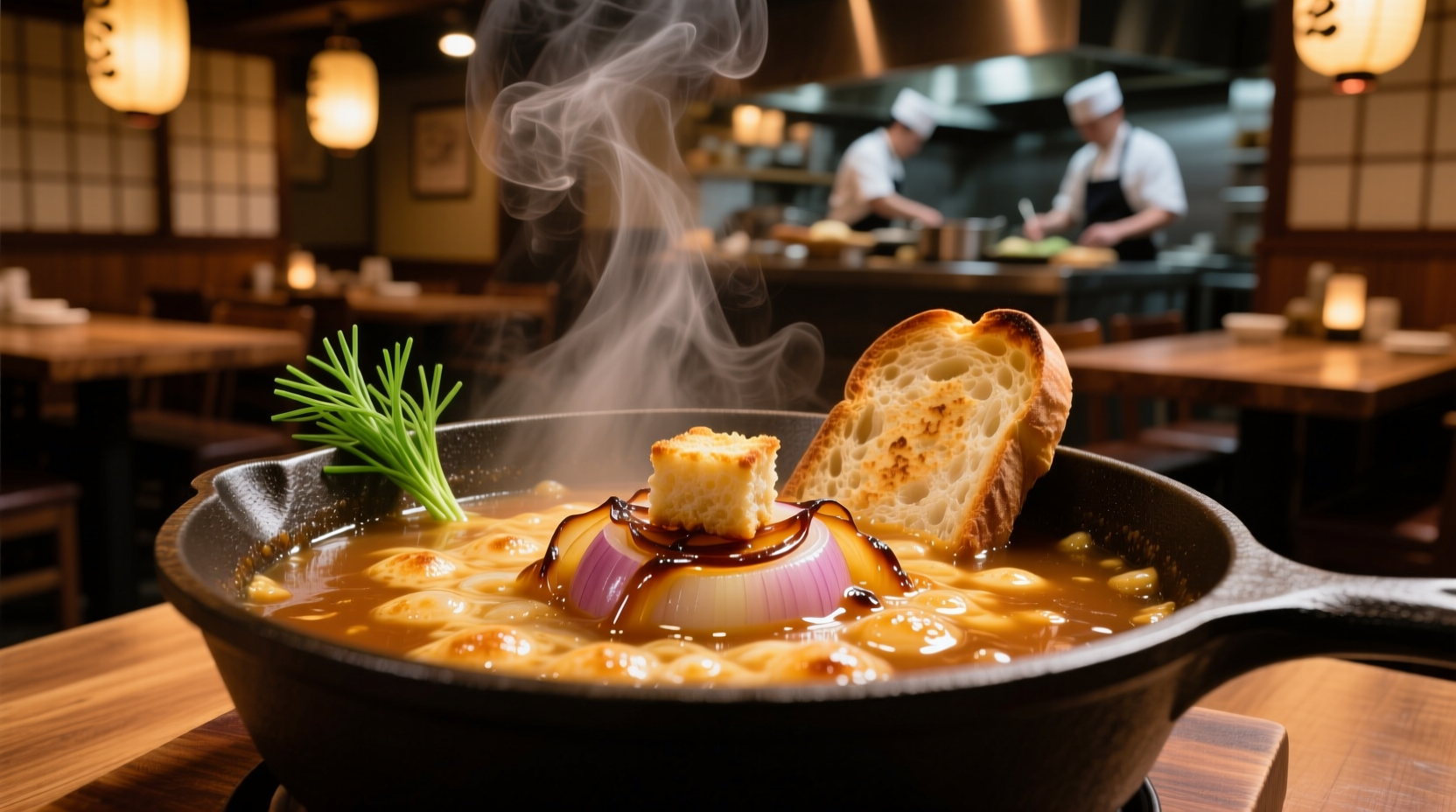Benihana onion soup is actually a miso-based soup featuring caramelized onions, not a French onion soup variant. This popular menu item at Benihana restaurants combines Japanese miso paste with sweet onions, creating a savory umami-rich broth that serves as a traditional starter in Japanese dining culture.
When you sit down at Benihana and that warm, aromatic soup arrives, you're experiencing a carefully crafted dish that blends Japanese culinary tradition with American steakhouse dining. Despite its name, Benihana onion soup isn't the French-style cheese-topped onion soup you might expect—it's a Japanese-inspired miso soup with caramelized onions that creates its distinctive sweet-savory flavor profile.
Understanding the True Nature of Benihana's Signature Soup
Many diners mistakenly believe Benihana serves French onion soup, but this confusion stems from the menu description. The restaurant's "onion soup" is actually a variation of miso soup, a staple in Japanese cuisine. This misnomer has persisted for decades, creating widespread misunderstanding about this popular starter.
Unlike traditional French onion soup with its beef broth and melted cheese topping, Benihana's version features a delicate miso base enhanced with slowly caramelized onions. The soup delivers that signature umami depth Japanese cuisine is known for, with the onions providing natural sweetness that balances the salty miso.

Historical Context: How This Dish Became a Restaurant Staple
When Hiroaki "Rocky" Aoki founded Benihana in 1964, he aimed to introduce Japanese cuisine to American audiences in an accessible way. The "onion soup" emerged as part of this mission—adapting traditional miso soup by emphasizing the caramelized onions to appeal to Western palates familiar with French onion soup.
This culinary adaptation represents a fascinating example of food globalization. By the 1980s, the soup had become so popular that many customers began requesting it by name, cementing its place as a signature starter despite its departure from authentic Japanese miso soup preparation.
Key Ingredients and Their Culinary Roles
The magic of Benihana onion soup comes from just a few carefully selected ingredients working in harmony:
- White miso paste - Provides the foundational umami flavor with a milder, sweeter profile than red miso
- Yellow onions - Slowly caramelized to develop natural sweetness without bitterness
- Dashi stock - The Japanese soup stock that forms the liquid base
- Toasted sesame oil - Added at the end for aromatic complexity
- Scallions - For fresh garnish and color contrast
Professional chefs note that the quality of miso paste makes or breaks this soup. Authentic preparation requires using fresh, unpasteurized miso that hasn't been exposed to high heat, which would destroy its delicate flavor compounds and beneficial enzymes.
| Benihana Onion Soup | Traditional Japanese Miso Soup | French Onion Soup |
|---|---|---|
| Miso-based with caramelized onions | Simple miso paste in dashi | Beef broth with caramelized onions |
| Served as restaurant starter | Daily household staple | Traditional French bistro dish |
| Mild umami with sweet notes | Clean umami flavor | Rich meaty flavor |
| Quick service restaurant preparation | Home-prepared in minutes | Slow-simmered for hours |
Practical Home Preparation Guide
While Benihana keeps their exact recipe proprietary, you can create a close approximation at home by following these professional techniques:
- Perfect the caramelization - Cook sliced onions slowly over medium-low heat for 30-40 minutes until deeply golden but not burnt
- Choose quality miso - Select white (shiro) miso from refrigerated section for authentic flavor
- Maintain proper temperature - Never boil miso; stir it into broth just below simmering point
- Balance the elements - Aim for 1 tablespoon miso per cup of broth for ideal flavor intensity
- Add finishing touches - A few drops of toasted sesame oil just before serving enhances complexity
Food scientists at the Culinary Institute of America note that the Maillard reaction during onion caramelization creates over 25 different flavor compounds that interact with miso's glutamates, producing that distinctive savory-sweet profile diners love. This chemical interaction explains why rushed caramelization yields inferior results.
Authenticity Considerations and Limitations
It's important to recognize that Benihana onion soup represents Japanese-American fusion rather than authentic Japanese cuisine. Traditional miso soup in Japan rarely features caramelized onions as a primary ingredient—this adaptation specifically targets Western flavor preferences.
When attempting to recreate this dish at home, understand these key limitations:
- Commercial versions use specific miso blends not available to home cooks
- Restaurant kitchens maintain precise temperature control during caramelization
- Professional dashi preparation differs from instant versions home cooks typically use
- The high-volume production environment affects flavor development
Despite these limitations, home versions can still capture the essential flavor profile when prepared with attention to technique rather than exact ingredient replication.
Serving Traditions and Pairing Suggestions
At Benihana, this soup serves as the traditional first course before the main hibachi experience. The warm, umami-rich broth prepares your palate for the grilled meats and vegetables to follow—a practice rooted in Japanese dining philosophy where lighter dishes precede heavier ones.
When serving this soup at home, consider these authentic pairing suggestions:
- Follow with grilled salmon or chicken for a complete Japanese-inspired meal
- Pair with a light green tea to cleanse the palate between courses
- Complement with a simple cucumber sunomono salad for texture contrast
- Avoid heavy appetizers that would overwhelm the soup's delicate flavors
Japanese culinary tradition emphasizes the concept of 'awase'—harmonizing flavors across a meal. The soup's umami foundation creates a perfect bridge between courses, enhancing the overall dining experience when properly sequenced.
Frequently Asked Questions
Is Benihana onion soup actually French onion soup?
No, Benihana onion soup is not French onion soup. Despite its name, it's a Japanese-inspired miso soup featuring caramelized onions in a dashi broth. The restaurant's naming convention has created widespread confusion, but the dish contains no beef broth or cheese topping characteristic of traditional French onion soup.
What gives Benihana onion soup its distinctive flavor?
The distinctive flavor comes from the combination of white miso paste and slowly caramelized onions. The Maillard reaction during caramelization creates complex flavor compounds that interact with the umami-rich miso, producing a sweet-savory profile different from both traditional miso soup and French onion soup.
Can I make authentic Benihana onion soup at home?
While you can create a close approximation, the exact restaurant version uses proprietary ingredients and commercial preparation methods. Home versions can capture the essential flavor profile by properly caramelizing onions, using quality refrigerated miso paste, and maintaining proper temperature control when incorporating the miso into the broth.
Is Benihana onion soup gluten-free?
Traditional miso paste contains barley or other grains, making standard versions not gluten-free. However, some restaurants may use rice-based miso. If gluten is a concern, ask specifically about ingredients when dining out, or use certified gluten-free miso when preparing at home.
Why does Benihana call it onion soup instead of miso soup?
Benihana uses "onion soup" on their menu to make the dish more approachable for American diners unfamiliar with miso. This marketing decision dates back to the restaurant chain's founding in the 1960s when Japanese ingredients were less widely recognized in the United States. The name emphasizes the most recognizable ingredient to Western audiences.











 浙公网安备
33010002000092号
浙公网安备
33010002000092号 浙B2-20120091-4
浙B2-20120091-4